The Consequences of Climate Change in the Brazilian Western Amazon: A New Proposal for a Fire Risk Model in Rio Branco, Acre
Abstract
:1. Introduction
- Evaluate the impact of meteorological variables and the ENSO phenomenon on the occurrence of fires;
- Identify fire risks for different land uses and covers;
- Create a fire risk index for the capital Rio Branco, Acre, Brazil;
- Evaluate the behavior of fire risk in different IPCC scenarios;
- Promote this index as a monitoring tool and an alternative for obtaining new information about fires in the Amazon biome.
2. Materials and Methods
2.1. Study Area
2.2. Observed Meteorological Data and Fire Data
2.3. Deforestation and Agricultural Crop Data
2.4. IPCC Scenarios—SSP2-4.5 and SSP5-8.5 (Future)
2.5. Fire Risk Index and ENSO Events
2.6. Regression Model and Statistical Analysis of FIRERBR
2.7. Statistical Analysis
3. Results
3.1. Fire Foci
3.2. Deforestation and Agricultural Crops
3.3. FIRERBR and Future
3.4. Statistical Analysis
4. Discussion
4.1. Forest Fires and Anthropic Advance in the Western Amazon
4.2. FIRERBR for Baseline and the Future in the Western Amazon
5. Conclusions
Author Contributions
Funding
Data Availability Statement
Acknowledgments
Conflicts of Interest
References
- IPCC. Climate Change 2021: The Physical Science Basis. Contribution of Working Group I to the Sixth Assessment Report of the Intergovernmental Panel on Climate Change. Available online: https://report.ipcc.ch/ar6/wg1/IPCC_AR6_WGI_FullReport.pdf (accessed on 30 November 2023).
- Buffon, F.T.; Pinheiro, J.A.C.; Castro, H.P.e.; Barbosa, F.d.A.d.R.; Mendonça, R.R.; Gomes, W.R.; Gramacho, P.C.; Bezerra, S.R. Enchente de 2015 no rio Acre: Aquisição de dados e monitoramento. In Simpósio Brasileiro De Recursos Hídricos; ABRH: Brasília, Brazil, 2015. [Google Scholar]
- Bonotto, G.; Buffon, F.T.; Mendonça, R.R. Estações específicas e tendências geomorfológicas no rio Acre. In Simpósio Brasileiro De Recursos Hídricos; ABRH: Florianópolis, Brazil, 2017. [Google Scholar]
- Le Page, Y.; Morton, D.; Hartin, C.; Bond-Lamberty, B.; Pereira, J.M.C.; Hurtt, G.; Asrar, G. Synergy between land use and climate change increases future fire risk in Amazon forests. Earth Syst. Dynam. 2017, 8, 1237–1246. [Google Scholar] [CrossRef]
- Barni, P.E.; Rego, A.C.M.; Silva, F.D.C.F.; Lopes, R.A.S.; Xaud, H.A.M.; Xaud, M.R.; Barbosa, I.B.; Fearnside, P.M. Logging Amazon forest increased the severity and spread of fires during the 2015–2016 El Niño. For. Ecol. Manag. 2021, 500, 119652. [Google Scholar] [CrossRef]
- Duarte, M.L.; Brito, W.B.M.; da Silva, T.A.; de Castro, A.L. Padrões e causas do desmatamento no Baixo Acre, região oeste da Amazônia brasileira. J. Environ. Anal. 2020, 5, 117–127. [Google Scholar] [CrossRef]
- Lawrance, D.; Vandecar, K. Effects of tropical deforestation on climate and agriculture. Nat. Clim. Change 2015, 5, 27–36. [Google Scholar] [CrossRef]
- Alencar, A.A.; Brando, P.M.; Asner, G.P.; Putz, F.E. Landscape fragmentation, severe drought, and the new Amazon forest fire regime. Ecol. Appl. 2015, 25, 1493–1505. [Google Scholar] [CrossRef]
- Santos, R.O.; Delgado, R.C.; Vilanova, R.S.; de Santana, R.O.; de Andrade, C.F.; Teodoro, P.E.; Lima, M. NMDI application to monitor the vegetation of the Atlantic Forest biome, Brazil. Weather Clim. Extremes 2021, 33, 100329. [Google Scholar] [CrossRef]
- Chelli, S.; Maponi, P.; Campetella, G.; Monteverde, P.; Foglia, M.; Paris, E.; Lolis, A.; Panagopoulos, T. Adaptation of the Canadian fire weather index to Mediterranean forests. Nat. Hazards 2015, 75, 1795–1810. [Google Scholar] [CrossRef]
- Nunes, J.R.S.; Soares, R.V.; Batista, A.C. FMA+—Um novo índice de perigo de incêndios florestais para o estado do Paraná, Brasil. Floresta 2006, 36, 75–91. [Google Scholar] [CrossRef]
- Eugenio, F.C.; dos Santos, A.R.; Pedra, B.D.; Pezzopane, J.E.M.; da Silva, S.D.P.; Fantinel, R.A. System for calculating and defining classes in modified Monte Alegre Formula—FMA+ Sisclass. Floresta 2021, 52, 131–139. [Google Scholar] [CrossRef]
- Delgado, R.C.; Wanderley, H.S.; Pereira, M.G.; Almeida, A.Q.d.; Carvalho, D.C.d.; Lindemann, D.d.S.; Zonta, E.; Menezes, S.J.M.d.C.d.; Santos, G.L.d.; Santana, R.O.d.; et al. Assessment of a New Fire Risk Index for the Atlantic Forest, Brazil. Forests 2022, 13, 1844. [Google Scholar] [CrossRef]
- Dhar, T.; Bhatta, B.; Aravindan, S. Forest fire occurrence, distribution and risk mapping using geoinformation technology: A case study in the sub-tropical forest of the Meghalaya, India. Remote Sens. Appl. Soc. Environ. 2023, 29, 100883. [Google Scholar] [CrossRef]
- Barmpoutis, P.; Kastridis, A.; Stathaki, T.; Yuan, J.; Shi, M.; Grammalidis, N. Suburban Forest Fire Risk Assessment and Forest Surveillance Using 360-Degree Cameras and a Multiscale Deformable Transformer. Remote Sens. 2023, 15, 1995. [Google Scholar] [CrossRef]
- Shao, Y.; Wang, Z.; Feng, Z.; Sun, L.; Yang, X.; Zheng, J.; Ma, T. Assessment of China’s forest fire occurrence with deep learning, geographic information and multisource data. J. For. Res. 2023, 34, 963–976. [Google Scholar] [CrossRef]
- Brody-Heine, S.; Zhang, J.; Katurji, M.; Pearce, H.G.; Kittridge, M. Wind vector change and fire weather index in New Zealand as a modified metric in evaluating fire danger. Int. J. Wildland Fire 2023, 32, 872–885. [Google Scholar] [CrossRef]
- Chen, Z.; Zhang, C.; Li, W.; Gao, L.; Liu, L.; Fang, L.; Zhang, C. Fire danger forecasting using machine learning-based models and meteorological observation: A case study in Northeastern China. Multimed. Tools Appl. 2023, 1, 1–21. [Google Scholar] [CrossRef]
- Delgado, R.C.; Santana, R.O.d.; Gelsleichter, Y.A.; Pereira, M.G. Degradation of South American biomes: What to expect for the future? Environ. Impact Assess. Rev. 2022, 96, 106815. [Google Scholar] [CrossRef]
- Li, L.; Vrieling, A.; Skidmore, A.; Wang, T.; Turak, E. Monitoring the dynamics of surface water fraction from MODIS time series in a Mediterranean environment. Int. J. Appl. Earth. Obs. Geoinf. 2018, 66, 135–145. [Google Scholar] [CrossRef]
- Barbosa, M.L.F.; Delgado, R.C.; Andrade, C.F.d.; Teodoro, P.E.; Junior, C.A.S.; Wanderley, H.S.; Capristo-Silva, G.F. Recent trends in the fire dynamics in Brazilian Legal Amazon: Interaction between the ENSO phenomenon, climate and land use. Environ. Dev. 2021, 39, 100648. [Google Scholar] [CrossRef]
- Alvares, C.A.; Stape, J.L.; Sentelhas, P.C.; Gonçalves, J.D.M.; Sparovek, G. Köppen’s climate classification map for Brazil. Meteorol. Zeitschrift 2013, 22, 711–728. [Google Scholar] [CrossRef]
- Silva Júnior, L.A.S.; Delgado, R.C.; Pereira, M.G.; Teodoro, P.E.; Silva Junior, C.A.d. Fire dynamics in extreme climatic events in western amazon. Environ. Dev. 2019, 32, 100450. [Google Scholar] [CrossRef]
- Bento, V.; Lima Jucá, E.V.; Menezes, R.S.d.; Lima, B.C.d.L.; Veras, N.M.; Moura, S.S. Interpretando a diversidade climática do Acre através da leitura de climogramas. Uáquiri 2022, 3, 2. [Google Scholar] [CrossRef]
- IBGE. Brasil/Acre. Available online: https://cidades.ibge.gov.br/brasil/ac/panorama (accessed on 5 December 2023).
- Arévalo, S.M.M.; Delgado, R.C.; Lindemann, D.d.S.; Gelsleichter, Y.A.; Pereira, M.G.; Rodrigues, R.d.Á.; Justino, F.B.; Wanderley, H.S.; Zonta, E.; Santana, R.O.d.; et al. Past and Future Responses of Soil Water to Climate Change in Tropical and Subtropical Rainforest Systems in South America. Atmosphere 2023, 14, 755. [Google Scholar] [CrossRef]
- Xavier, A.C.; Scanlon, B.R.; King, C.W.; Alves, A.I. New improved Brazilian daily weather gridded data (1961–2020). Int. J. Climatol. 2022, 42, 8390–8404. [Google Scholar] [CrossRef]
- Volpato, M.; Andrade, C.F.; Silva, E.L.; Barbosa, M.L.; Andrade, M.D.; Rocha, P.V.; Delgado, R.C.; Teodoro, P.E.; Silva, C.A.; Pereira, M.G. Fire foci and their spatiotemporal relations to weather variables and land uses in the state of Mato Grosso. Environ. Dev. Sustain. 2023, 25, 12419–12438. [Google Scholar] [CrossRef]
- SGB. RADAM-D. Available online: https://www.sgb.gov.br/publique/Geologia/Sensoriamento-Remoto-e-Geofisica/RADAM-D-628.html (accessed on 20 December 2023).
- INPE. Prodes—Amazônia. Available online: http://www.obt.inpe.br/OBT/assuntos/programas/amazonia/prodes (accessed on 10 December 2023).
- IBGE. PAM—Produção Agrícola Municipal. Available online: https://www.ibge.gov.br/estatisticas/economicas/agricultura-e-pecuaria/9117-producao-agricola-municipal-culturas-temporarias-e-permanentes.html?edicao=18051&t=series-historicas (accessed on 10 December 2023).
- Copernicus Climate Change Service. CMIP6 Climate Projections. Available online: https://cds.climate.copernicus.eu/cdsapp#!/dataset/projections-cmip6?tab=overview (accessed on 10 December 2023).
- Mann, H.B. Nonparametric tests against trend. Econom. J. Econom. Soc. 1945, 13, 245–259. [Google Scholar] [CrossRef]
- Kendall, K. Thin-film peeling-the elastic term. J. Phys. D: Appl. Phys. 1975, 8, 1449–1452. [Google Scholar] [CrossRef]
- Pettitt, A.N. A non-parametric approach to the change-point problem. Appl. Stat. 1979, 28, 126–135. [Google Scholar] [CrossRef]
- Ferreira, I.J.M.; Campanharo, W.A.; Barbosa, M.L.F.; Silva, S.S.d.; Selaya, G.; Aragão, L.E.O.C.; Anderson, L.O. Assessment of fire hazard in Southwestern Amazon. Front. For. Glob. Change. 2023, 6, 1107417. [Google Scholar] [CrossRef]
- Mataveli, G.; de Oliveira, G.; Silva-Junior, C.H.L.; Stark, S.C.; Carvalho, N.; Anderson, L.O.; Gatti, L.V.; Aragão, L.E.O.C. Record-breaking fires in the Brazilian Amazon associated with uncontrolled deforestation. Nat. Ecol. Evol. 2022, 6, 1792–1793. [Google Scholar] [CrossRef]
- Kerr, G.H.; DeGaetano, A.T.; Stoof, C.R.; Ward, D. Climate change effects on wildland fire risk in the Northeastern and Great Lakes states predicted by a downscaled multi-model ensemble. Theor. Appl. Climatol. 2018, 131, 625–639. [Google Scholar] [CrossRef]
- Faria, B.L.; Brando, P.M.; Macedo, M.N.; Panday, P.K.; Soares-Filho, B.S.; Coe, M.T. Current and future patterns of fire-induced forest degradation in Amazonia. Environ. Res. Lett. 2017, 12, 095005. [Google Scholar] [CrossRef]
- Nações Unidas Brasil. Últimos Oito Anos Foram Os Mais Quentes Já Registrados, Revela Relatório Das Nações Unidas. Available online: https://brasil.un.org/pt-br/228847-últimos-oito-anos-foram-os-mais-quentes-já-registrados-revela-relatório-das-nações-unidas (accessed on 18 December 2023).
- Notícias do Acre. Com Safra Recorde, Produção de Milho E Soja No Acre É A Maior Em 30 Anos. Available online: https://agencia.ac.gov.br/com-safra-recorde-producao-de-milho-e-soja-no-acre-e-a-maior-em-30-anos/ (accessed on 19 December 2023).
- Padrão, G.d.A.; Lirio, V.S.; De Lima, J.E. Determinantes do desmatamento na Amazônia legal: Um estudo de caso do estado do Acre. Rev. De Adm. E NegÓCios Da Amaz. 2016, 8, 85–108. [Google Scholar] [CrossRef]
- Rodrigues, A.F.; Mello, C.R.D.; Terra, M.D.C.N.S.; Beskow, S. Water balance of an Atlantic forest remnant under a prolonged drought period. Ciência E Agrotecnol. 2021, 45, e008421. [Google Scholar] [CrossRef]
- INMET. 2023 É O Mais Quente Em 174 Anos, Confirma Relatório Da OMM. Available online: https://portal.inmet.gov.br/noticias/2023-é-o-mais-quente-em-174-anos-confirma-relatório-da-omm (accessed on 20 December 2023).
- Santos, R.O.; Delgado, R.C.; Pereira, M.G.; Souza, L.P. Physical attributes of the river basin of Roncador river associated to the landscape change in the municipality of Magé, Rio de Janeiro-Brazil. Biosci. J. 2018, 34, 1146–1155. [Google Scholar] [CrossRef]


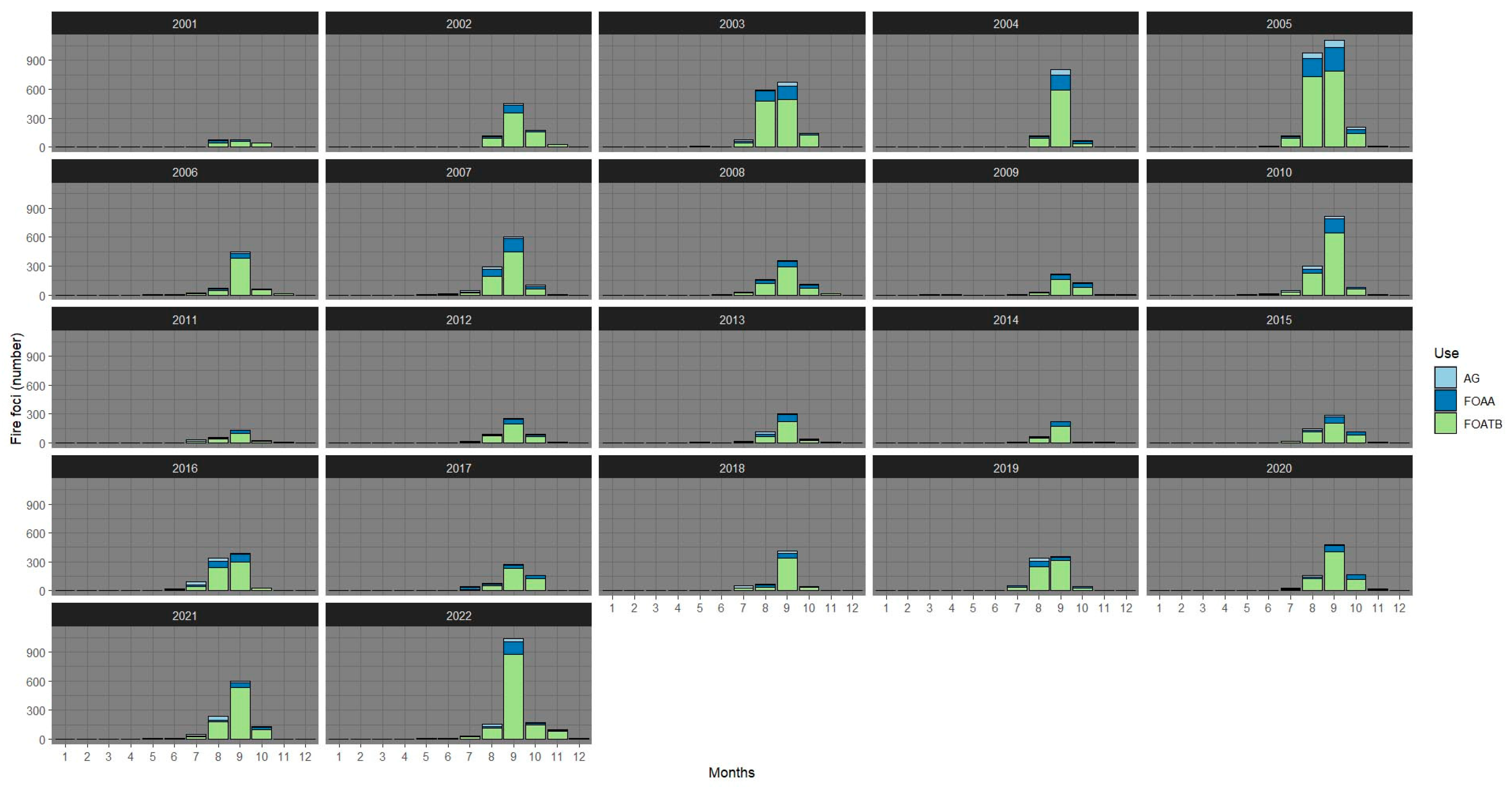

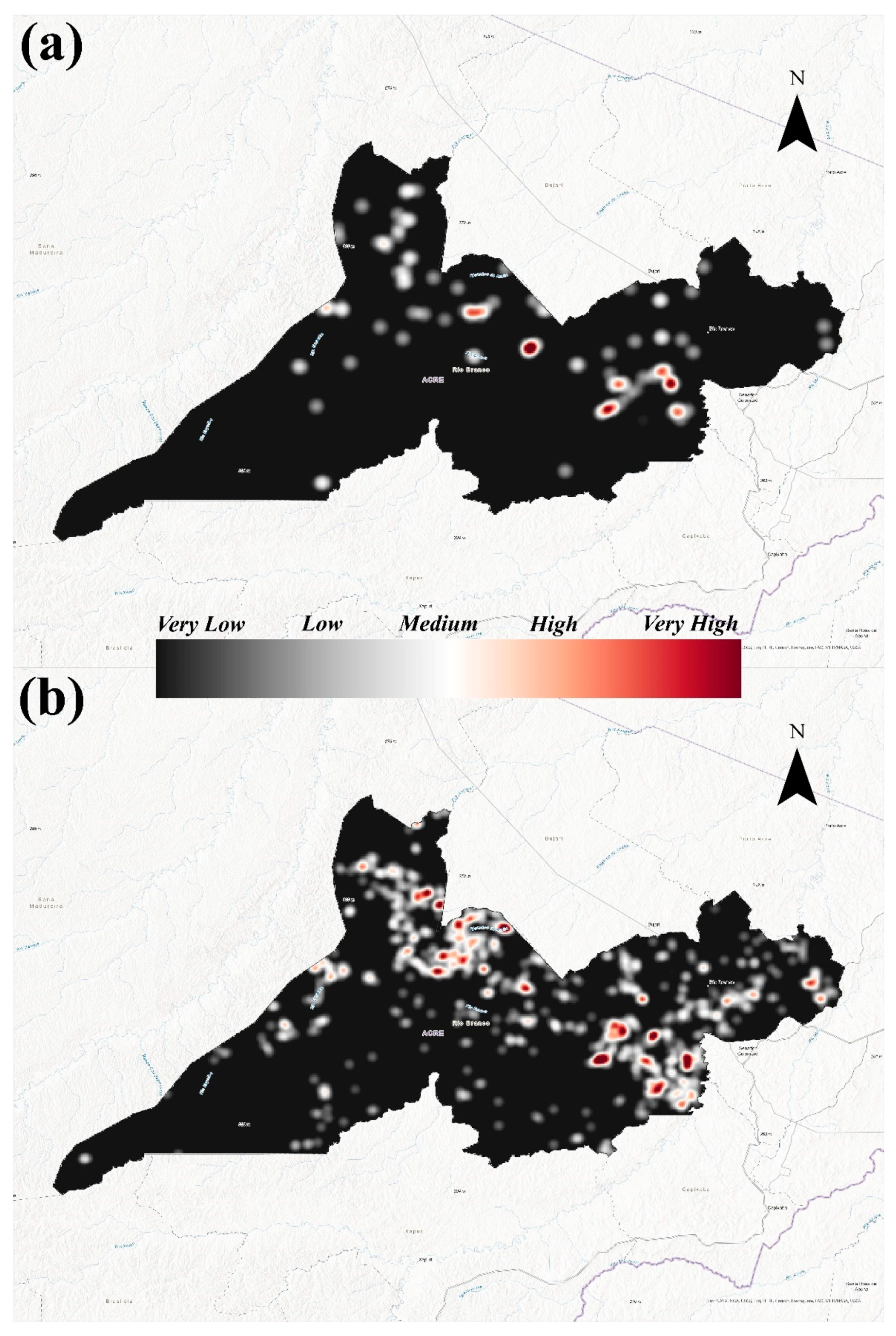

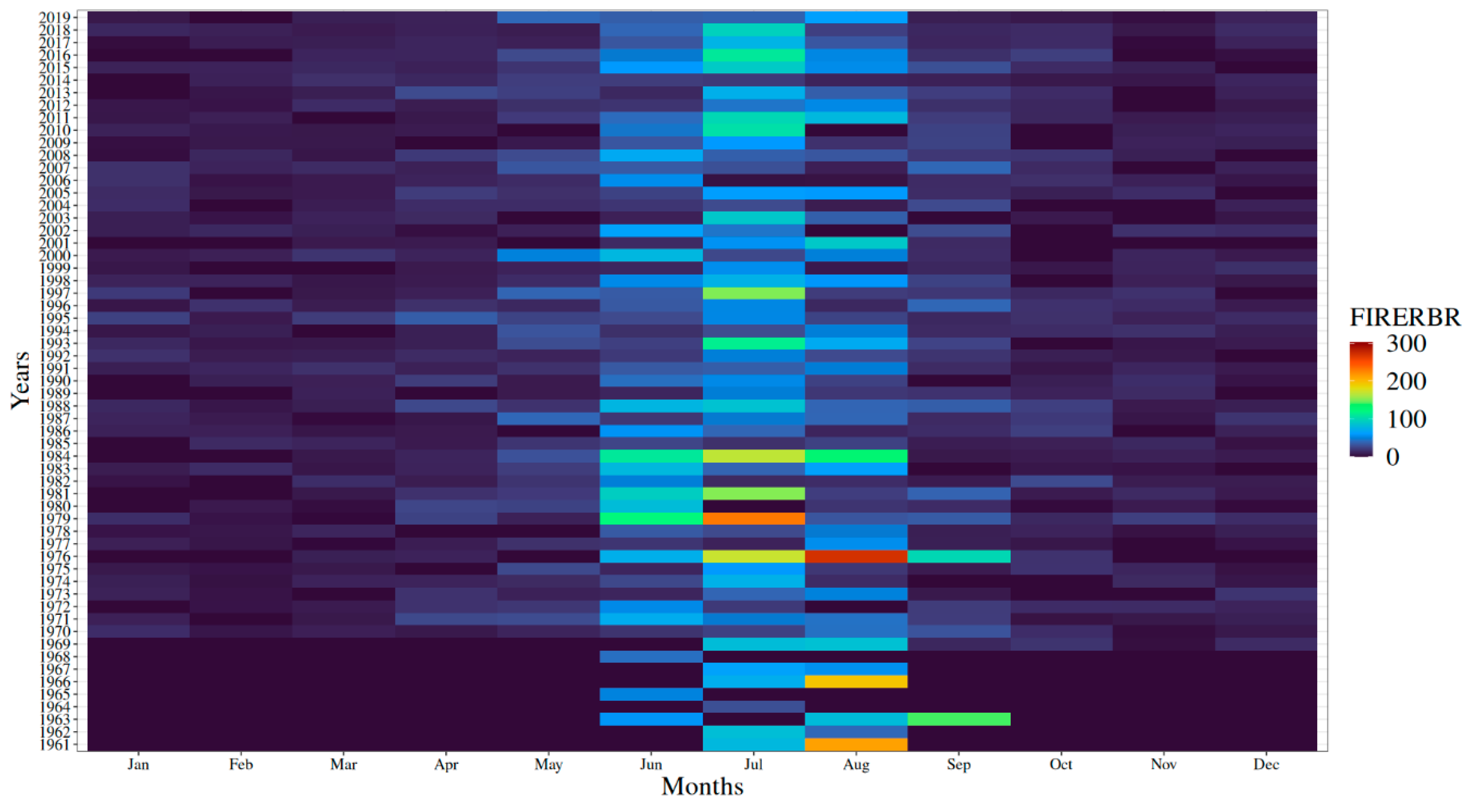
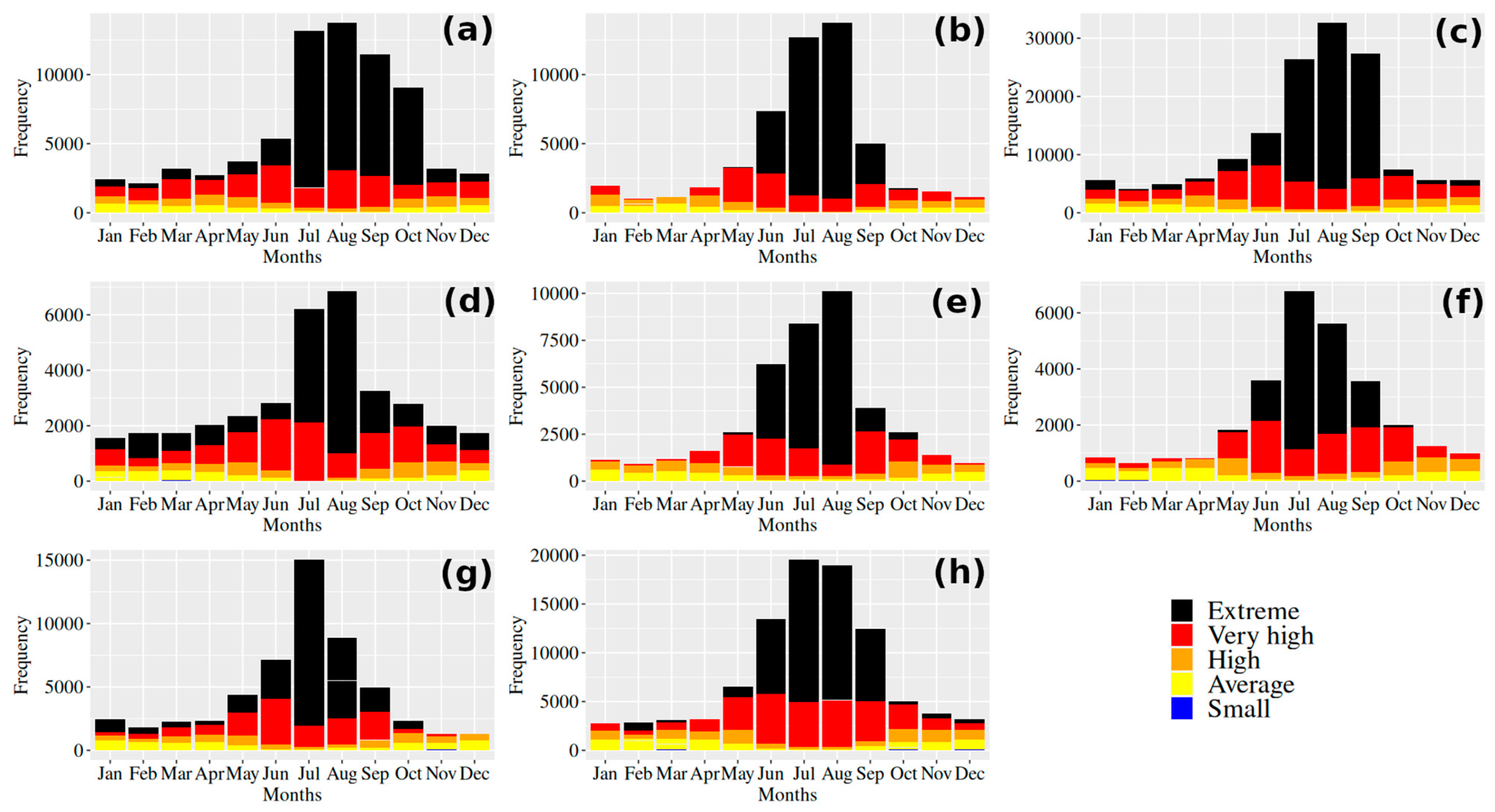
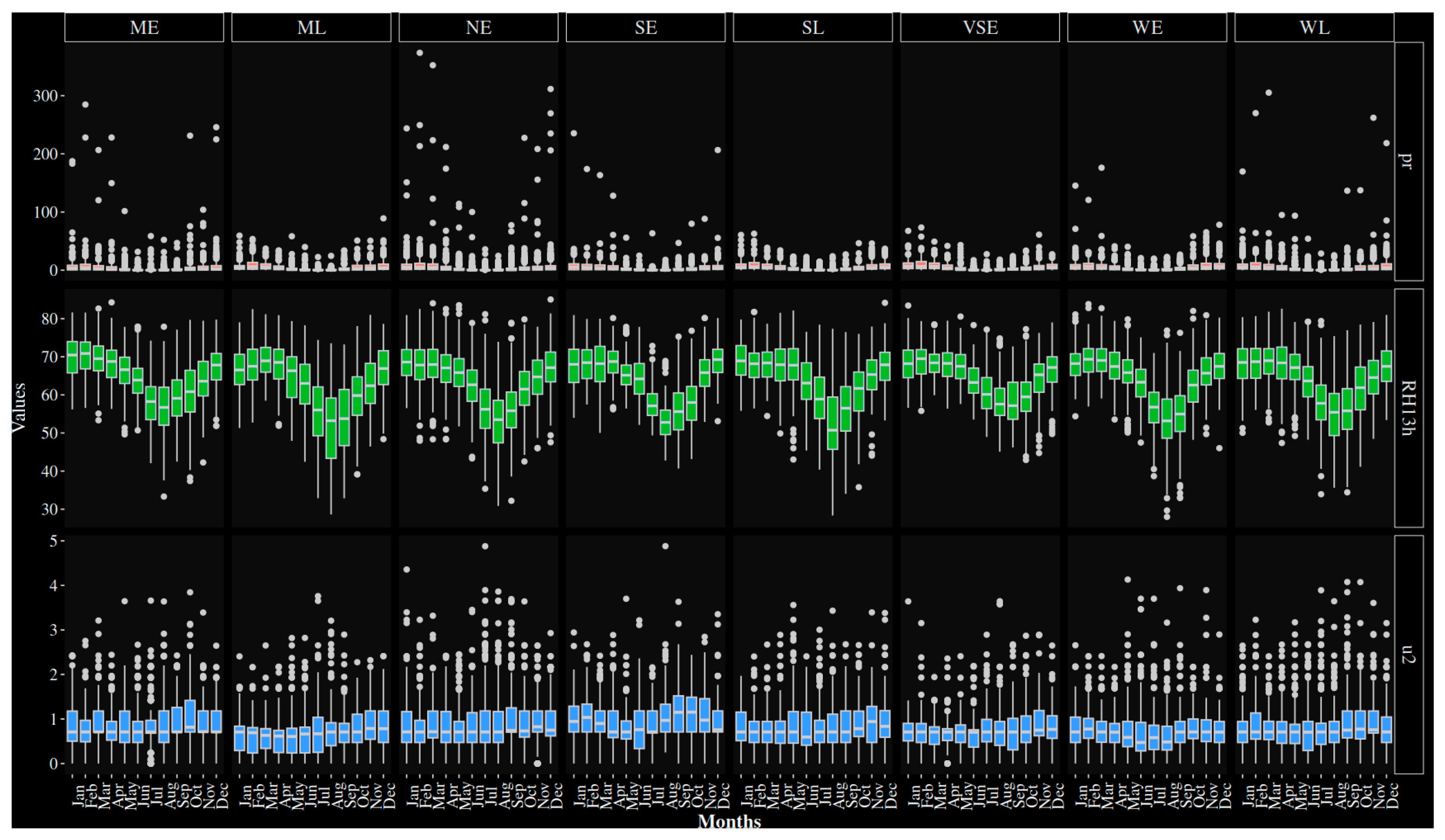
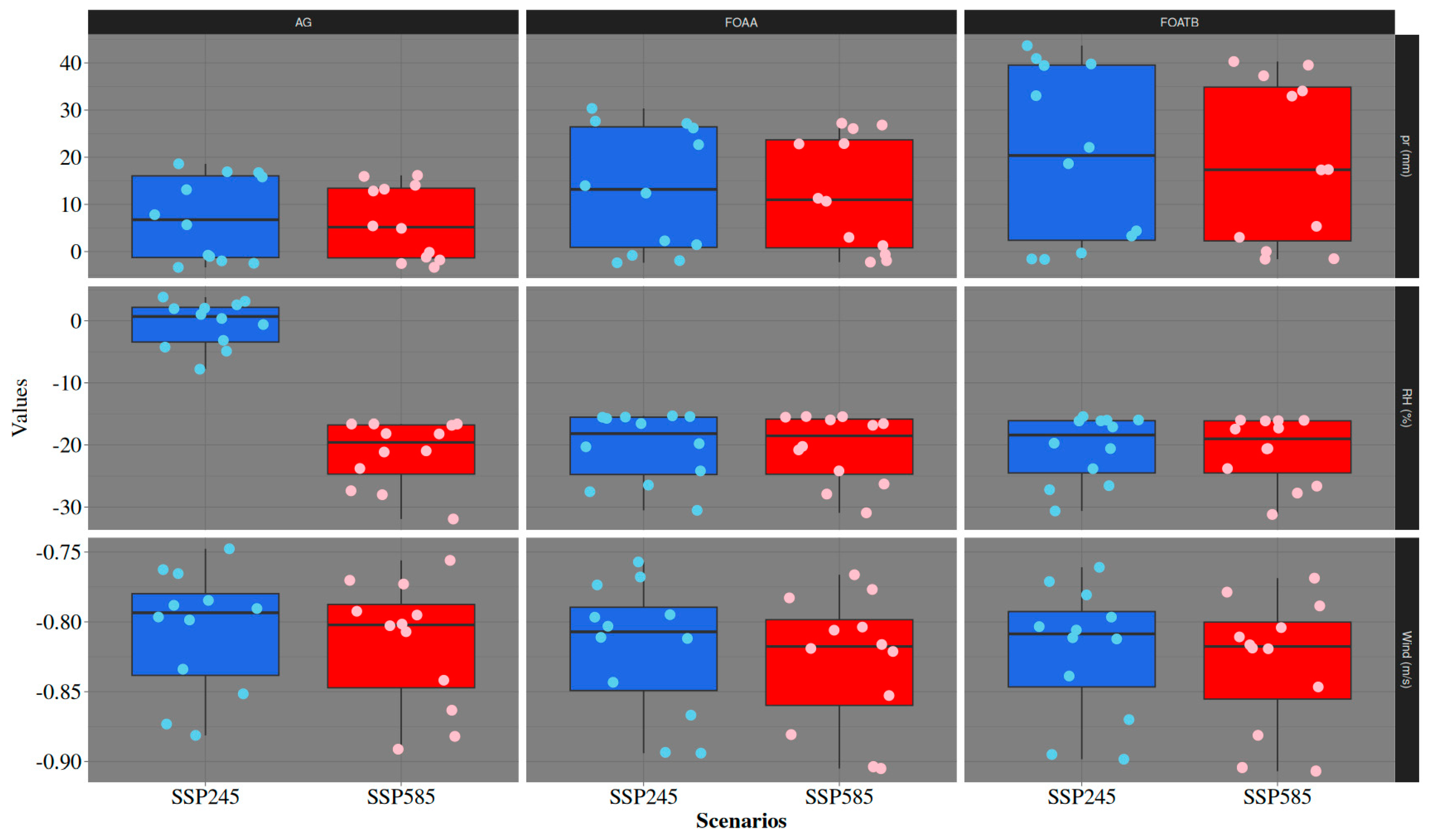
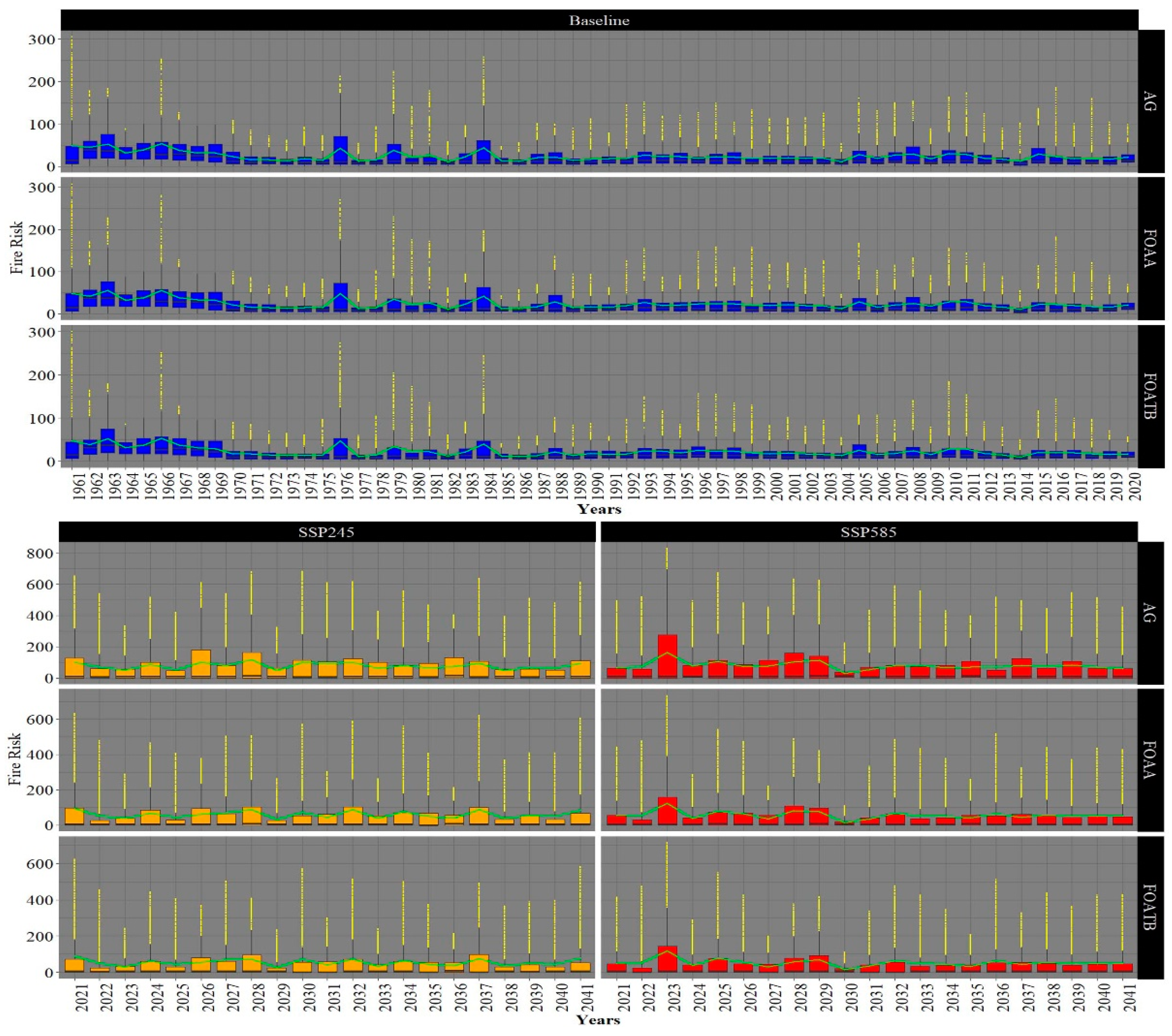

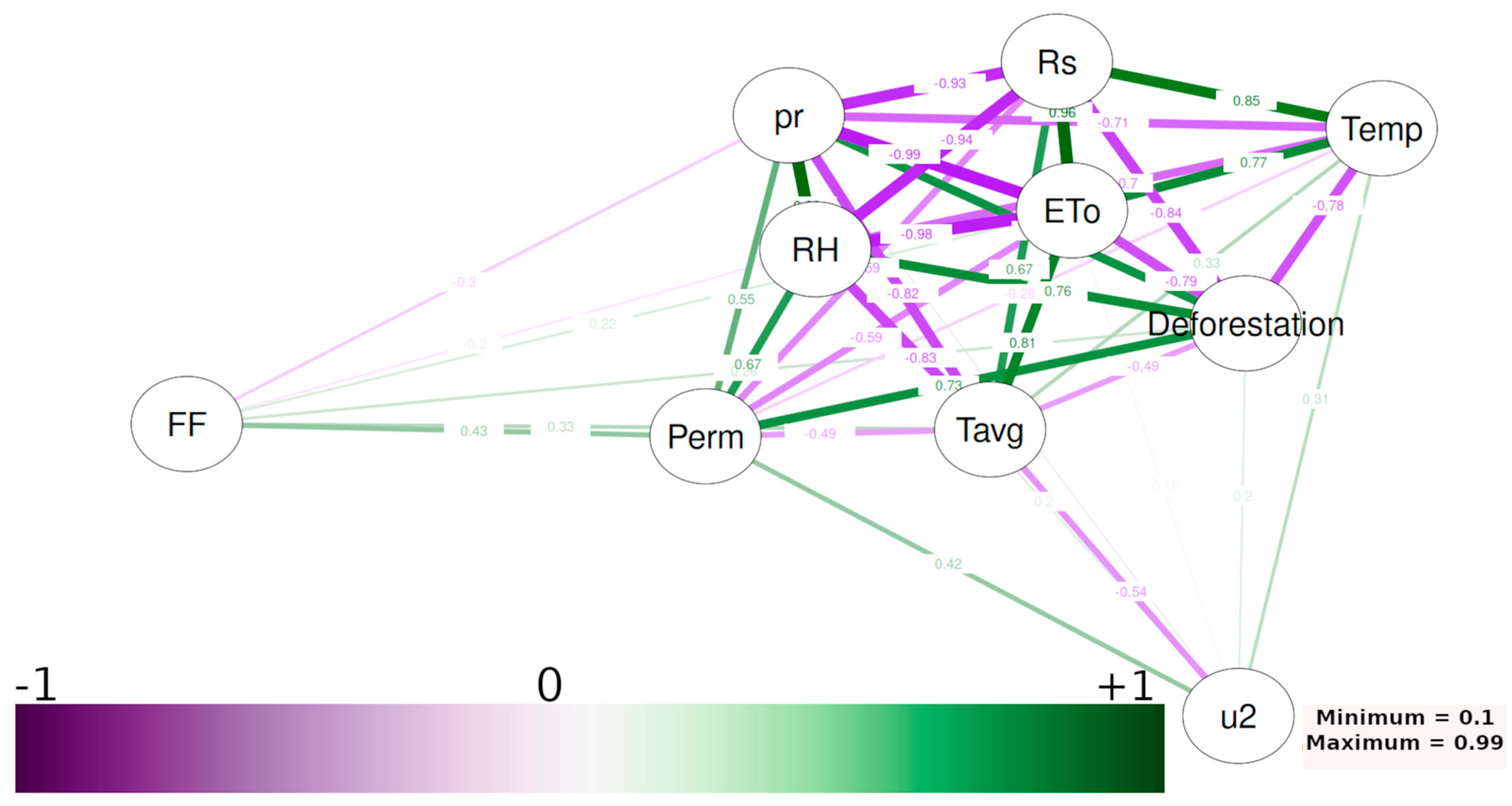
| Years | ENSO Event | Years | ENSO Event | Years | ENSO Event |
|---|---|---|---|---|---|
| 1961 | NE | 1981 | NE | 2001 | NE |
| 1962 | NE | 1982 | VSE | 2002 | ME |
| 1963 | ME | 1983 | WL | 2003 | NE |
| 1964 | WL | 1984 | ML | 2004 | WE |
| 1965 | SE | 1985 | NE | 2005 | WL |
| 1966 | NE | 1986 | ME | 2006 | WE |
| 1967 | NE | 1987 | SE | 2007 | SL |
| 1968 | ME | 1988 | SL | 2008 | WL |
| 1969 | WE | 1989 | WL | 2009 | SE |
| 1970 | ML | 1990 | NE | 2010 | SL |
| 1971 | WL | 1991 | SE | 2011 | ML |
| 1972 | VSE | 1992 | NE | 2012 | NE |
| 1973 | SL | 1993 | NE | 2013 | NE |
| 1974 | WL | 1994 | ME | 2014 | WE |
| 1975 | ML | 1995 | WL | 2015 | VSE |
| 1976 | ME | 1996 | NE | 2016 | WL |
| 1977 | ME | 1997 | VSE | 2017 | WL |
| 1978 | WL | 1998 | ML | 2018 | WE |
| 1979 | WE | 1999 | SL | 2019 | WE |
| 1980 | NE | 2000 | WL | 2020 | ML |
| Months | ETo | Pr | RH | Rs | Tmax | Tmin | Tavg | u2 |
|---|---|---|---|---|---|---|---|---|
| January | * | * | −2.61 | * | * | * | * | * |
| February | * | −1.84 | −2.33 | * | * | * | * | * |
| March | 1.74 | * | −2.72 | * | 1.70 | * | * | −2.60 |
| April | 3.06 | * | −3.20 | 1.80 | 2.25 | * | * | −3.25 |
| May | * | * | −2.26 | * | * | 2.26 | 2.39 | −3.34 |
| June | * | * | * | * | * | 2.02 | 2.34 | * |
| July | −1.67 | * | * | * | 2.16 | 2.62 | 1.83 | * |
| August | * | 2.91 | −3.03 | * | 3.14 | 2.42 | * | −2.95 |
| September | * | * | −3.48 | * | * | * | 3.55 | −2.44 |
| October | * | * | −3.41 | * | 3.11 | * | * | −1.69 |
| November | * | * | −3.27 | * | 3.03 | * | * | * |
| December | * | −2.20 | −3.73 | * | * | * | * | * |
Disclaimer/Publisher’s Note: The statements, opinions and data contained in all publications are solely those of the individual author(s) and contributor(s) and not of MDPI and/or the editor(s). MDPI and/or the editor(s) disclaim responsibility for any injury to people or property resulting from any ideas, methods, instructions or products referred to in the content. |
© 2024 by the authors. Licensee MDPI, Basel, Switzerland. This article is an open access article distributed under the terms and conditions of the Creative Commons Attribution (CC BY) license (https://creativecommons.org/licenses/by/4.0/).
Share and Cite
Melo, K.d.S.; Delgado, R.C.; Pereira, M.G.; Ortega, G.P. The Consequences of Climate Change in the Brazilian Western Amazon: A New Proposal for a Fire Risk Model in Rio Branco, Acre. Forests 2024, 15, 211. https://doi.org/10.3390/f15010211
Melo KdS, Delgado RC, Pereira MG, Ortega GP. The Consequences of Climate Change in the Brazilian Western Amazon: A New Proposal for a Fire Risk Model in Rio Branco, Acre. Forests. 2024; 15(1):211. https://doi.org/10.3390/f15010211
Chicago/Turabian StyleMelo, Kennedy da Silva, Rafael Coll Delgado, Marcos Gervasio Pereira, and Givanildo Pereira Ortega. 2024. "The Consequences of Climate Change in the Brazilian Western Amazon: A New Proposal for a Fire Risk Model in Rio Branco, Acre" Forests 15, no. 1: 211. https://doi.org/10.3390/f15010211
APA StyleMelo, K. d. S., Delgado, R. C., Pereira, M. G., & Ortega, G. P. (2024). The Consequences of Climate Change in the Brazilian Western Amazon: A New Proposal for a Fire Risk Model in Rio Branco, Acre. Forests, 15(1), 211. https://doi.org/10.3390/f15010211







